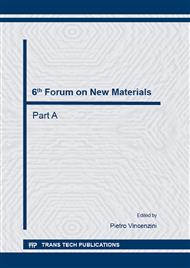p.219
p.225
p.235
p.241
p.247
p.252
p.260
p.264
p.270
Effect of Temperature on Phase Transition of Ni-Co Oxide and its Application on Optoelectronics
Abstract:
Ni-Co thin films were prepared on glass substrate by RF magnetron sputtering technique. Post-deposition annealing of Ni-Co film in oxygen atmosphere was found to improve film structure and electrical characteristics. The correlation between annealing conditions and the physical structure of the films was investigated by X-ray diffraction (XRD), scanning electron microscopy (SEM) and UV-Vis-NIR spectrophotometer. The lowest resistivity was observed after annealing a sputter-deposited Ni-Co film at 600 °C for 5h. The transmittance showed more than 85% in the infrared range. The preferred annealing condition has been found to improve Ni-Co film characteristics for transparent conducting material applications.Keywords: Ni-Co film, annealing, phase transition
Info:
Periodical:
Pages:
247-251
Citation:
Online since:
October 2014
Authors:
Keywords:
Price:
Сopyright:
© 2014 Trans Tech Publications Ltd. All Rights Reserved
Share:
Citation:


